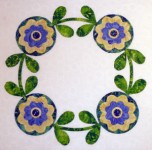 | Available On:
December 01, 2010 Instructions no longer available | "Ring around the Roses" The childhood song, "Ring around the rosies, pocket full of posies; ashes, ashes, we all fall down!" is a fun singing game for young children. It first showed up in print in an 1881 Kate Greenaway edition of Mother Goose, although it was around earlier. Some people associate the song with the outbreak of the Bubonic plague, alleging that the words equate to the plague's rosy rash, sneezing, air-purifying posies, and the ashes of death. Scholars have discounted this theory, noting that the explanation does not match historical records. This month's "Ring Around the Roses" block is the final one in this block-of-the-month series. Once you finish it, you will work on the cornerstones, borders, and assembling the quilt. What a great journey this has been! Let's get started on the last leg of the trip. |